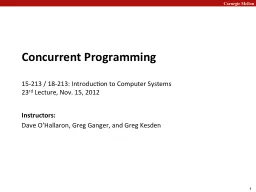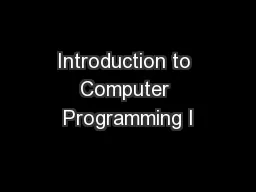PPT-Concurrent Programming 15-213 / 18-213: Introduction to Computer Systems
Author : aaron | Published Date : 2018-02-12
23 rd Lecture Nov 15 2012 Instructors Dave OHallaron Greg Ganger and Greg Kesden Concurrent Programming is Hard The human mind tends to be sequential The notion
Presentation Embed Code
Download Presentation
Download Presentation The PPT/PDF document "Concurrent Programming 15-213 / 18-213: ..." is the property of its rightful owner. Permission is granted to download and print the materials on this website for personal, non-commercial use only, and to display it on your personal computer provided you do not modify the materials and that you retain all copyright notices contained in the materials. By downloading content from our website, you accept the terms of this agreement.
Concurrent Programming 15-213 / 18-213: Introduction to Computer Systems: Transcript
Download Rules Of Document
"Concurrent Programming 15-213 / 18-213: Introduction to Computer Systems"The content belongs to its owner. You may download and print it for personal use, without modification, and keep all copyright notices. By downloading, you agree to these terms.
Related Documents











![[BEST]-Programming 11:C Programming Success in a Day & Rails Programming Professional](https://thumbs.docslides.com/980146/best-programming-11-c-programming-success-in-a-day-rails-programming-professional-made-easy-c-programming-c-programming-c-programming-language-rails-android-programming-ruby-rails-php-css.jpg)
![[PDF]-Programming 3: Python Programming Professional Made Easy & C Programming Success](https://thumbs.docslides.com/980147/pdf-programming-3-python-programming-professional-made-easy-c-programming-success-in-a-day-c-programming-c-programming-c-programming-language-html-python-programming-python-java-php.jpg)
![[FREE]-Programming 16: Python Programming In A Day & C Programming Professional Made Easy](https://thumbs.docslides.com/980148/free-programming-16-python-programming-in-a-day-c-programming-professional-made-easy-c-programming-c-programming-c-programming-language-html-python-python-programming-coding-css-java-php.jpg)